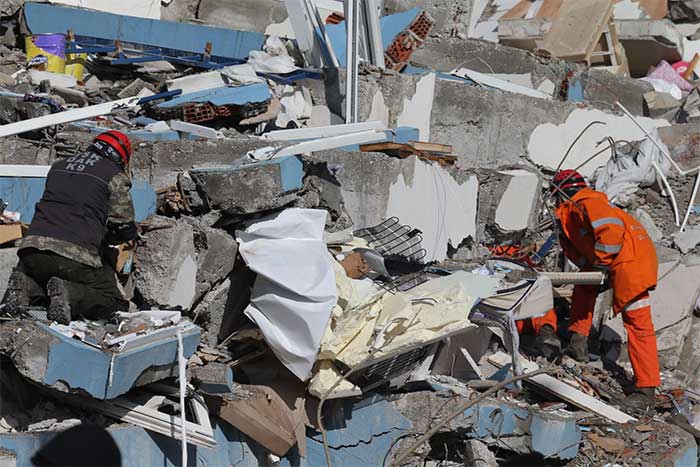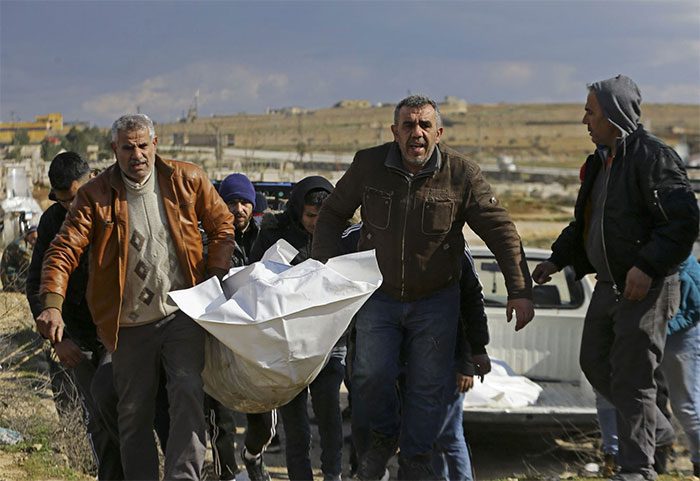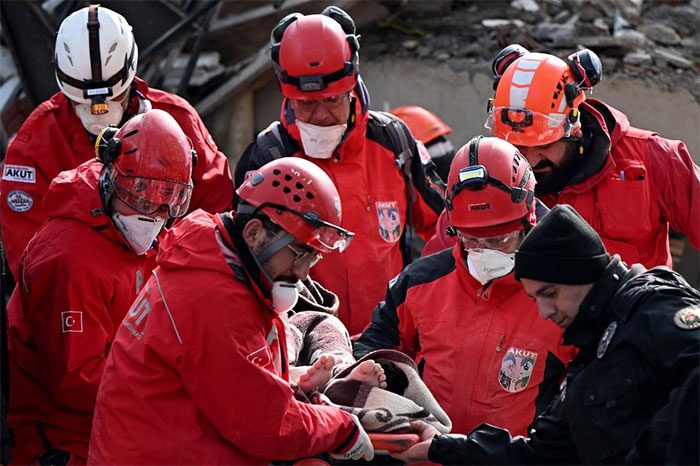A powerful 7.8 magnitude earthquake, accompanied by aftershocks, struck Turkey and Syria on February 6, resulting in a severe disaster. Rescue teams are racing against time to save survivors, supported by the international community.
Earthquake Equivalent to 32 Atomic Bombs

Rescue teams are searching for victims at the rubble site after the earthquake in Kahramanmaras, Turkey, on February 7, 2023. (Photo: THX/TTXVN).
The earthquake, measuring 7.8 on the Richter scale, struck at 4:17 AM, with its epicenter located approximately 18 km deep near Gaziantep, Turkey, around 60 km from the Syrian border. The toll on human life and property has rapidly escalated as rescue teams work diligently to locate survivors trapped under the debris of thousands of collapsed buildings.
As of the morning of February 8 (Hanoi time), the death toll has risen to nearly 7,900 people. A United Nations official noted that thousands of children may have perished. Turkish President Tayyip Erdogan declared a state of emergency in 10 provinces.
This is considered the strongest earthquake in nearly a century in the region. Renato Solidum, Director of the Philippines Institute of Volcanology and Seismology, stated in The New York Times that the energy released from the earthquake at the Turkey-Syria border is equivalent to 32 atomic bombs dropped on Hiroshima nearly 80 years ago.
According to Turkey’s Disaster and Emergency Management Authority, the earthquake has flattened over 5,600 buildings. A total of 14,720 personnel are currently engaged in relief efforts in the disaster-stricken area.
In a report issued about 30 minutes after the earthquake, American experts estimated a 34% chance that the death toll would range from 100 to 1,000, and a 31% chance it would range from 1,000 to 10,000. The economic damage is estimated to be equivalent to 1% of Turkey’s gross domestic product.
Turkey has officially requested assistance from the North Atlantic Treaty Organization (NATO) and allied nations to aid in disaster recovery efforts.
Causes of High Casualties from the Earthquake

Transporting the body of a victim after the earthquake in Aleppo, northern Syria on February 7. (Photo: AFP/TTXVN).
The number of casualties is expected to continue to rise as the severity of this disaster becomes clearer.
Experts indicate that several factors complicated the earthquake in Turkey and Syria. Mustafa Erdik, a professor at the Kandilli Observatory and Earthquake Research Institute at Bogazici University in Istanbul, told Al Jazeera: “One of the reasons for the high casualty rate is the poor quality of buildings.”
Turkey’s National Earthquake Action and Strategy Plan for the 2012-2023 period emphasized that the rapid and massive migration in the 1950s led to an unmanaged urban development process, making cities highly vulnerable to natural disasters.
Following the 1999 earthquake, Turkish organizations recognized the urgent need to mitigate risks, given the country’s susceptibility to earthquakes. The following year, Turkey passed legislation to enforce mandatory design checks and construction inspections for all buildings. However, buildings constructed to earthquake-resistant design standards remain a minority. Erdik stated, “The buildings that collapsed were all built before 2000.”
Another reason for the high casualty count is that the first earthquake struck while people were asleep: at 4:17 AM (local time), trapping many under the rubble.
Chris Elders, a professor at Curtin University in Australia, noted that the shallow epicenter also contributed to the earthquake’s severity.
The World Comes Together for Recovery Efforts
Immediately following the earthquake, the world quickly mobilized to assist Turkey and Syria in recovery efforts.

Rescue teams transporting the bodies of victims after the earthquake in Kahramanmaras, Turkey, on February 7, 2023. (Photo: AFP/TTXVN).
United Nations (UN) aid agencies have launched coordinated efforts to assist thousands of victims in both countries. UN Secretary-General António Guterres issued a statement affirming the UN’s full commitment to support recovery efforts from the earthquake, confirming that UN relief teams are on the ground in Turkey and Syria assessing necessary needs. The UN is calling on the international community to support the thousands of people affected by this disaster, many of whom require urgent humanitarian aid and are trapped in hard-to-reach areas.
According to the World Health Organization (WHO), approximately 23 million people, including 1.4 million children, in both countries may be affected by the earthquake. The WHO is sending emergency relief supplies and activating a network of emergency medical teams to support the earthquake-affected area.
Countries are also dispatching support teams to the disaster area. The Russian Emergency Ministry reported that over 100 of its rescue personnel, along with necessary equipment, have arrived in Turkey to assist in the earthquake recovery efforts.
German Foreign Minister Annalena Baerbock stated that Germany will allocate an additional 1 million euros to the aid organization Malteser International and is seeking to provide financial support to other humanitarian partners to assist earthquake victims in Syria.
Philippine President Ferdinand Romualdez Marcos also announced that the country will send a team of 85 people to Turkey to assist in search and rescue operations for earthquake victims.
On February 7, King Salman and Crown Prince Mohammed bin Salman of Saudi Arabia directed the King Salman Relief and Humanitarian Aid Center to establish an air bridge to assist victims of the earthquake in Syria and Turkey.
On the same day, Egyptian President Abdel-Fattah El-Sisi ordered the dispatch of five military aircraft carrying emergency medical aid to Turkey and Syria to contribute to relief efforts.
Also on February 7, the first relief flights from Jordan and Kuwait took off, carrying rescue equipment, tents, logistical supplies, and medical aid for the earthquake victims in Syria and Turkey.
The Qatari Ministry of Foreign Affairs also announced that it will provide 10,000 mobile homes to Turkey and Syria. Previously, Qatari King Sheikh Tamim bin Hamad Al Thani ordered the establishment of an air bridge to support earthquake victims in Turkey.
The Lebanese Army announced that it will send 35 engineers to Syria and Turkey to assist in rescue operations in both countries. The Lebanese Civil Defense Force—responsible for search, rescue, and firefighting operations—is also sending specialized units to aid relief efforts in Syria and Turkey. The Lebanese Red Crescent organization stated that it will send rescue teams to both countries at the request of the governments of Syria and Turkey.
In an interview, Nguyễn Phú Tân Hương, First Secretary of the Vietnamese Embassy in Turkey, stated that the embassy is actively contacting local authorities and the Vietnamese community to gather information and is prepared to implement measures to protect citizens in the event that any Vietnamese nationals are victims of the earthquake, continuously monitoring the situation closely. As of February 6, there was no information about Vietnamese casualties, only reports of material damage.


















































